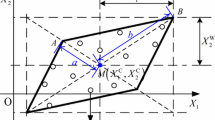Abstract
Often, we are interested in a quantity that is difficult or impossible to measure directly, e.g., tomorrow’s temperature. To estimate this quantity, we measure auxiliary easier-to-measure quantities that are related to the desired ones by a known dependence, and use the known relation to estimate the desired quantity. Measurements are never absolutely accurate, there is always a measurement error, i.e., a non-zero difference between the measurement result and the actual (unknown) value of the corresponding quantity. Often, the only information that we have about each measurement error is the bound on its absolute value. In such situations, after each measurement, the only information that we gain about the actual (unknown) value of the corresponding quantity is that this value belongs to the corresponding interval. Thus, the only information that we have about the value of the desired quantity is that it belongs to the range of the values of the corresponding function when its inputs are in these intervals. Computing this range is one of the main problems of interval computations. Lately, it was shown that in many cases, it is more efficient to compute the range if we first re-scale each input to the interval [0, 1]; this is one of the main ideas behind Constraint Interval Arithmetic techniques. In this paper, we explain the empirical success of this idea and show that, in some reasonable sense, this re-scaling is the best.
Access this chapter
Tax calculation will be finalised at checkout
Purchases are for personal use only
Similar content being viewed by others
References
L. Jaulin, M. Kiefer, O. Didrit, E. Walter, Applied Interval Analysis, with Examples in Parameter and State Estimation, Robust Control, and Robotics (Springer, London, 2001)
W.A. Lodwick, Constrained Interval Arithmetic, University of Colorado at Denver, Center for Computational Mathematics CCM, Report 138 (1999)
W.A. Lodwick, Interval and fuzzy analysis: an unified approach, in Advances in Imaging and Electronic Physics, vol. 148, ed. by P.W. Hawkes (Elsevier Press, 2017), pp. 75–192
W.A. Lodwick, D. Dubois, Interval linear systems as a necessary step in fuzzy linear systems. Fuzzy Sets and Systems 281, 227–251 (2015)
G. Mayer, Interval Analysis and Automatic Result Verification (de Gruyter, Berlin, 2017)
R.E. Moore, R.B. Kearfott, M.J. Cloud, Introduction to Interval Analysis (SIAM, Philadelphia, 2009)
S.G. Rabinovich, Measurement Errors and Uncertainty: Theory and Practice (Springer, New York, 2005)
Acknowledgements
This work was supported in part by the National Science Foundation grants 1623190 (A Model of Change for Preparing a New Generation for Professional Practice in Computer Science), and HRD-1834620 and HRD-2034030 (CAHSI Includes), and by the AT&T Fellowship in Information Technology.
It was also supported by the program of the development of the Scientific-Educational Mathematical Center of Volga Federal District No. 075-02-2020-1478, and by a grant from the Hungarian National Research, Development and Innovation Office (NRDI).
Author information
Authors and Affiliations
Corresponding author
Editor information
Editors and Affiliations
Rights and permissions
Copyright information
© 2023 The Author(s), under exclusive license to Springer Nature Switzerland AG
About this chapter
Cite this chapter
Bede, B., Tuyako Mizukoshim, M., Ceberio, M., Kreinovich, V., Lodwick, W. (2023). Why Constraint Interval Arithmetic Techniques Work Well: A Theorem Explains Empirical Success. In: Ceberio, M., Kreinovich, V. (eds) Uncertainty, Constraints, and Decision Making. Studies in Systems, Decision and Control, vol 484. Springer, Cham. https://doi.org/10.1007/978-3-031-36394-8_51
Download citation
DOI: https://doi.org/10.1007/978-3-031-36394-8_51
Published:
Publisher Name: Springer, Cham
Print ISBN: 978-3-031-36393-1
Online ISBN: 978-3-031-36394-8
eBook Packages: Intelligent Technologies and RoboticsIntelligent Technologies and Robotics (R0)




